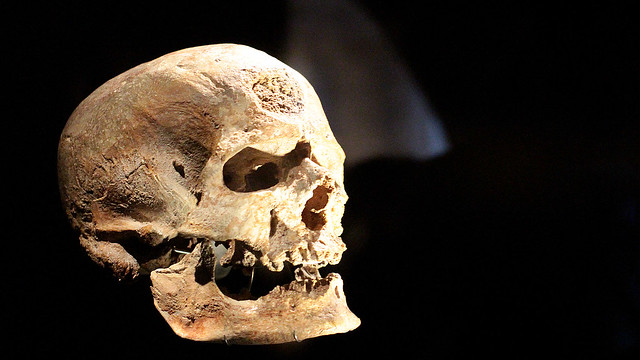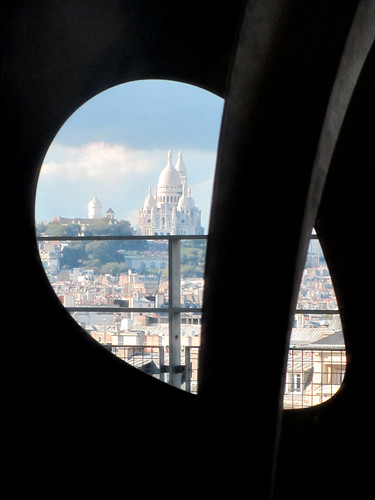I never knew Musée de l’Homme in its past incarnation. For as long as I can remember – well, six years apparently – it has been closed for renovation. Unbeknownst to me, I have actually seen a good portion of its (former) collection of Asian, African, American and Oceanian ethnography appropriated to fill the legacy project of a certain Monsieur Chirac. How lucky for Musée du Quai Branly and what uncertain time it left Musée de l’Homme, as its European ethnographic collection was also packed away to Musée des Civilisations de l’Europe et de la Méditerranée (MuCEM) in Marseille.


From emptying corridors came opportunity to change its mission. Musée de l’Homme evolved and is making a come back with fresh look and a restart. Housed within Palais de Chaillot, I need not have to emphasise what great view it has of the Eiffel Tower, do I? Thanks to my friend Céline, F and I got a sneak peak of it today before the museum opens its door to the public on Saturday, 17 October, and for the first three days, entry to the museum will be free.
Continue reading »
My ignorance about the history of Denmark (and Scandinavian countries) shows. Sure, we have this notion of Viking Age that reigned supreme, and I don’t know about you, but I have embarassingly little knowledge of Danes’ cultural identity, their nation, their kinship, etc. We popped in to the National Museum of Denmark, hoping to learn a few more things, and then we were duly lured by the bright sunshine outside to leave… Terrible, I know.


Continue reading »
What is the common denominator between an immigrant, an expatriate, a foreigner, an alien and a non-citizen? Me. And countless others like me. We who fit the aforementioned, albeit with situations that vary in thousand shades of paperwork grade. Time and time again, the debate, in particular the pitting of an immigrant against an expatriate, can be painfully divisive. Just search for “immigrant vs expat” and you’ll see all kind of perception attached to these words, of social standing, origin, wealth, skin colour, intention. The fight is ugly.


The topic of immigration is a sensitive one and the question of integration has been contentiously thrashed out, in public and in private alike. At times of economic hardship, the subject is paraded – not only in France, mind – like an evil which must be stopped (UKIP’s Nigel Farage would like everyone to go back to where they came from, thank you very much) and the rhetorics filled with “selected truths”. My visit over the weekend to the Musée de l’Histoire de l’Immigration (i.e. Museum of Immigration History) was therefore an interesting one, one where I get to explore briefly the stories of the people who make France the nation it is today.
Continue reading »
Let me just put it out there – if anyone ever feel like giving me something but not sure what makes a good gift, one of the sure things would be an annual museum pass. It doesn’t matter if it’s a solo or a duo card – although the latter is handy to bring F or a friend with me – as long as I get to enjoy the many different exhibitions around town. ;)

Some of the perks attached to these passes?
– No queuing to enter a museum nor its exhibition(s)
– Share the joy of museum visits without queuing (with duo card)
– Multiple visits to interesting (temporary) exhibitions
– Discounts for purchases at the gift shop
– Discounts for guided visits or exhibition conferences
– Free/discounted tickets of affiliated sites/museums
– Free/discounted tickets to linked/special events
Continue reading »
Museums are teeming with all thing curious, interesting, beautiful, ugly, etc that I could spend an entire day in a large one or hop from a small one to another, and would most likely happily repeat the same the next day. (I even own a couple of museum cards so I have unlimited access all year round to these museums without having to queue for ticket each time). Monuments, on the other hand, showcase history through architecture and events that occur on these sites. No less fascinating on their own.

Cue: free museums and monuments Sunday
In Paris-talk, this Sunday refers to the first Sunday of the month. Free entry to check out something different and informative each month – sweet deal!
Continue reading »

Musée Marmottan Monet is a gem. A little out of the way perhaps, it sits just at the eastern edge of Bois de Boulogne. There are no pomps to announce its presence just beyond a small playground in mainly, from what I gathered, a residential area. However, what’s hidden behind the seemingly plain façade is another story altogether.
The museum is one primarily dedicated to Impressionism, an art movement which I can’t seem to get enough of. I may as well admit now that I hold an annual pass to Musée d’Orsay so I could visit anytime in the year to indulge in my whims for the romance in Impressionist works, not to mention the added bonus of entry to Musée de l’Orangerie whenever I wish. Paris was central to the birth of Impressionism and I believe no better city could have been chosen for it to flourish. Today, Paris is also the best city to admire many of the masterpieces produced during the short time-span of the movement.
Continue reading »

With my friends from Dublin visiting, and seeing today’s also the first Sunday of the month when many museums and historical landmarks are free to visit, we opted for the Museum of Modern Art at Centre Pompidou. It has an amazing collection, ranging from the “classics” (Picasso, Miro, Gris etc) to the quirky (there are pieces I have yet to decipher) – just the perfect place to spend a lovely afternoon together.
Something outside the windows kept catching my attention – the Basilica of Sacré-Cœur. And with it, it brought to mind an exhibition by Henri Rivière which I saw a couple of years back, displaying some prints of 36 Views of Eiffel Tower, which in turn was inspired by Hokusai’s 36 Views of Mount Fuji. Can I call dibs on photographic version of 36 Views of Sacré-Cœur? I can’t imagine it would be easy with a point-n-shoot camera, especially for distant views. Now that we’re coming into winter too, daylight hours are limited (I do need to work) and absolute clear days at weekends may be hard to come by. We’ll see…

Tucked away in the rather posh and affluent 8th arrondissement is Musée Jacquemart-André, formerly home to a certain Monsieur Jacquemart and his wife Madame J neé André. Not a museum frequently visited by foreign tourists, there was nonetheless a queue when I went there for a visit with my friend, most of them French and trying to catch the Caillebotte Brothers exhibition before its closure in a couple of weeks. Like me really. I’ve been wanting to see the Impressionist-half of the siblings, while being mildly curious about the photographer-half of the duo.
The museum is absolutely stunning. I could not justifiably describe it – it is something you should see for yourself. The tropical conservatory, ornated staircases, decorated apartments and opulent dining room are but some of the features. The dining room is today a café that serves delicious salads and a few other special dishes, and they entice diners in by displaying a mouth-watering selection of cakes and tarts right by the door to enter the eatery. Smart marketing move ;)

If you ever find yourself crossing River Seine southward at Pont d’Austerlitz, you will see this magnificent building right ahead, surrounded by a beautiful garden. When I saw it for the first time, I wondered whose grand palatial residence could it be. But this is Paris, where real estate is at its premium, so really, who could afford to live in a place like this?
Turns out, a bunch of preserved (or models of) animals and plants. Or so I am assuming since it is the site of the Grande Galerie de l’Evolution, aka the Natural History Museum of Paris, and other NHMs that I’ve been to tend to house items of similar vein. I still have not yet been there for a visit – I should – but I have been told by an ex-colleague in Dublin how wonderful this place is. Certainly, the setting from the exterior has been charming. Now it remains how captivated I would be when I venture in one day.

Gustav III Museum of Antiquities is a rather peculiar museum. It is a museum of a museum, that is, it is a museum recreated based on the museum which used to be housed at the Royal Palace. For a period of time, these pieces were moved to National Museum. They were subsequently restored at the Palace once again, and reopened as Museum of Antiquities. Therefore, this is a museum honouring what was one of the oldest European museums.
The museum is not particularly big, consisting of only two galleries. The bigger one containing a number of key statues, including Apollo and his nine muses, and Endymion, while the narrower gallery is used to mostly display busts of men of fame in the past. What’s quite amusing was listening to the guide explaining how rogue merchants of the past classified something as an object of antiquities from Roman civilisation. Apparently, as long as there’s at least 30% of original parts to the work, it was considered antiquities. And missing parts (limbs, attributes) can subsequently be replaced by, say, reconstructive sculpting works. Intriguing.

























